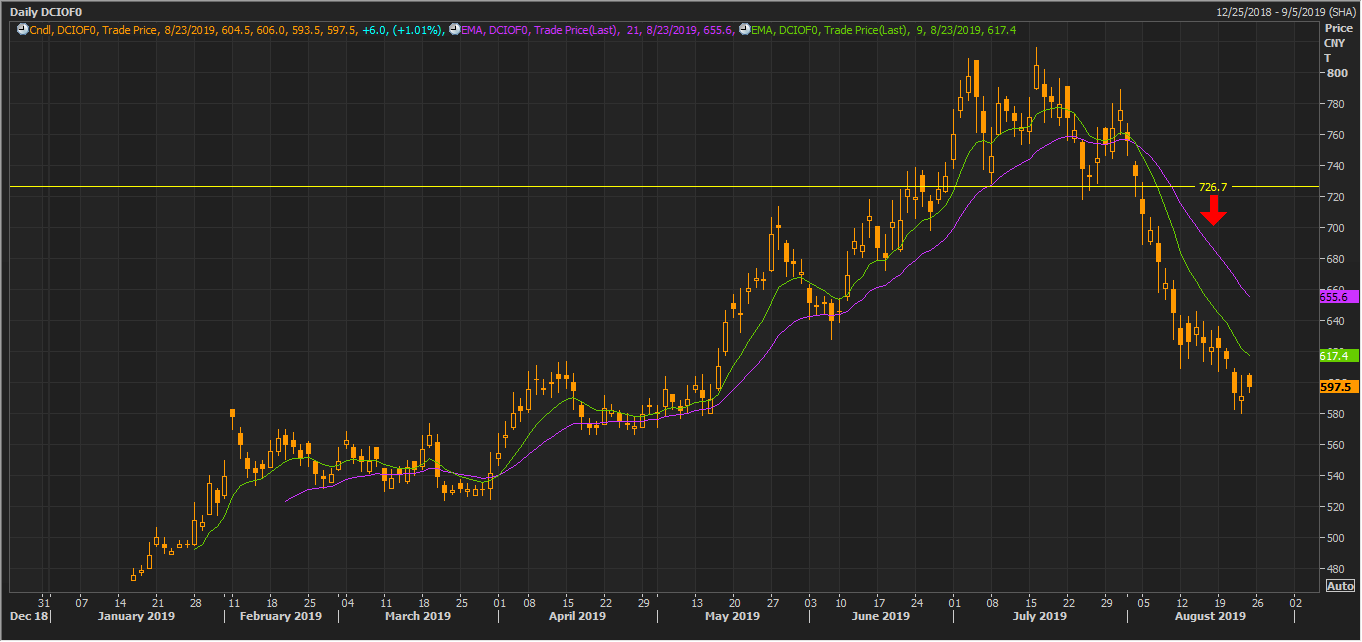Iron ore prices took a hit in the market as demand slump push the Chinese steelmakers to extend the production cut. Apart from demand pessimism, the recent fall in the iron ore prices is ignited by the Australian iron ore behemoth-BHP Billiton (ASX:BHP).
Iron ore prices nose-dived on the Dalian Commodity Exchange in China and the prices of the most actively traded 62 per cent graded iron ore futures fell from the level of RMB 924.50 (Dayâs high on 17 July 2019) to the present low of RMB 580.0 (Dayâs low on 22 August 2019).
Likewise, the prices of iron ore in the international market or on the Chicago Mercantile Exchange (or CME) dropped from the level of US$117.14 a tonne on 30 July to the present low of US$92.73 a tonne on 22 August 2019.
Whatâs Cooking in the Iron Ore Market?
Couple of steelmakers in Hubei and landlocked provinces in China recently announced their plans for production curtailments as the high costs and falling steel prices shunned the profit margins of steel mills and pushed them to the verge of losses.
The steelmakers in China further anticipate demand-fall ahead of the Military World Games from 18 October 2019 to 27 October 2019.
The decision from steelmakers of the Hubei and landlocked provinces came into limelight post the announcement from the steelmakers of other provinces such as Shanxi, Sichuan, etc., in Central China.
The consensus over the production cut reduced the demand for iron ore in China, which in turn, exerted pressure on iron ore prices in the domestic market.
The European Jolt:
The European Union (or EU) decided to do away with the Brazilian stainless steels from its proposal for adjustments to the current safeguard measures on steel imports in the domestic market.
The safeguard withdrawal would further increase the presence of the Brazilian steel in Europe, which in turn, could further add additional pressure on the Chinese steel exporters.
As per the data, over 18 per cent of the Brazilian stainless steel exports entered the European market, while China only exported 360,000 mt in 2018, which in turn, represented 9 per cent of the total stainless steel imports.
When it comes to the stainless steel, China faces a close competition with Brazil, and the removal of the safeguard measure could create a problem for China, which is already facing a probe over the anti-dumping in the European market.
Further Production Curbs Coming Ahead:
Wuâan- a county-level city in the Hebei provinces is extending the production cut from 22 August 2019 to 31 August 2019, which would require the sintering machine to clean up and blast furnace to remain idle.
The industry experts estimate that the production curb from the Wuâan city would cut the demand of 120,000mt iron ore from the market.
The bearish stance adopted by the steelmakers in China reduced the iron ore demand, and the prices of the raw material plunged in the market.
How Would it Impact the Steel Market?
The production cut from the steelmakers is likely to intensify the steel fundamentals in future, which in turn, could support the steel prices.
The improved steel prices could prompt the steelmakers to again ramp up the production amidst a steel supply shortage in China. The steel inventory in China has recently touched the level of 14.74 million tonnes.
However, the gloomy global growth outlook and weaker demand remain a potential risk for the steel and iron ore market.
Iron Ore Market from BHPâs Lens:
In its recent yearly announcement, the Australian iron ore mammoth- BHP mentioned that, albeit, the global steel production maintained a healthy growth during the second half of the 2019 financial year, the growth profile is now unbalanced.
The company further highlighted that the current margins of the steel mills are normalising (previously high margins), and the iron ore quality would be a crucial element for the price formation.
BHP whose share prices felt the twin-shock of falling copper, and iron ore prices mentioned that the company expects the global growth to register near the lower end of a range of 3.25 per cent to 3.75 per cent in the calendar year 2019.
BHP remained cautious over the global economic outlook, and the company mentioned that any further escalation in the trade tussle is a downside risk to the economic forecast of the company.
BHP expects Chinaâs growth to slow modestly in CY2019 to around 6.25 per cent, and the company further anticipates that over the longer-term chinaâs economic growth would deaccelerate as the working-age population falls and the capital stock matures.
The pessimistic outlook from the Australia giant jolted the market sentiments and the iron ore prices nose-dived in the market.
BHP Production Normalises:
BHP kept the Western Australia iron ore production guidance for FY2020 in the range of 273-286 million tonnes, and while the company maintained high production guidance, the Brazilian mammoth- Vale operations are now on a ramp-up.
The combined large production from such miners could finally narrow down the existing gap between the global supply and demand, which previously widen over the array of events such as the Vale suspension, impact of Tropical Cyclone Veronica, etc.
Iron Ore Market Today:
 DCIOF0 Daily Chart (Source: Thomson Reuters)
DCIOF0 Daily Chart (Source: Thomson Reuters)
On the daily chart, the prices recovered slightly today and managed to cross the previous day high; however, the bears soon again dominated the downtrend, and the prices are again trading in the red zone.
 DCIOF0 Hourly Chart (Source: Thomson Reuters)
DCIOF0 Hourly Chart (Source: Thomson Reuters)
On the hourly chart, the prices are currently taking the support of 161.8 per cent (or RMB 583.4) projected level of the Fibonacci series. The immediate support for the prices remains at RMB 583. On the upper side, an immediate hurdle is intact at 100.0 per cent projected level (or RMB 603.8), While the major hurdle for the prices are intact at RMB 646.5
Investors should monitor these level closely as a break and sustain above these hurdles could indicate a short-term recovery in price; however, failure to do so would denote bears strength and resumption of the primary downtrend.
Why Are Bear Domoninating the Iron Ore Market?
Currently, the demand for iron ore among the steelmakers is low, due to which the physical traders are slashing the quotes, which in turn, is further exerting pressure on iron ore future contract on DCE.
However, the current low demand situation is narrowing down the spread between high grades and low grades iron ore, which in turn, could provide support to the 62 per cent graded contract.
Investors should further reckon the impact of a reduced spread between the grades and should monitor the above provided levels closely to fathom out the direction of the prices ahead.
Disclaimer
This website is a service of Kalkine Media Pty. Ltd. A.C.N. 629 651 672. The website has been prepared for informational purposes only and is not intended to be used as a complete source of information on any particular company. Kalkine Media does not in any way endorse or recommend individuals, products or services that may be discussed on this site. Our publications are NOT a solicitation or recommendation to buy, sell or hold. We are neither licensed nor qualified to provide investment advice.






